July 16, 2012

Pandora Sphinx Caterpiller
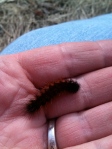
Wooly Bear Caterpillar
(Isabella Tiger Moth)
I guess I should have realized that if I invested in fancy new lights, borrowed a cool and quiet generator and picked up a nifty pop-up white sheet contraption, it would rain on the night of my moth program, my favorite of the entire year. I’ve been the naturalist here at Hill-Stead for going on six years, and I’ve tried to offer programs that will excite, educate and entertain. And I’m shameless. I’d stand on my head in the center of Farmington, Ct (where we are located) if it would make people see how exquisite and vital nature is to us, and how much Hill-Stead offers in terms of natural beauty and value.
When I was a child I was scared senseless by moths. Something about their fluttery-ness, and their nighttime habit really blotted out all reason in me. It was terrible-a naked, irrational phobia. And of course I had only seen the brown and gray jobs (talk about fifty shades of gray!) my mother referred to as “millers”. “Don’t be afraid, its’ just a miller,” she’d say, as I freaked out. What the heck is a “miller” anyway?
But later, as I grew as a naturalist I read of fantastic moths, pink and yellow, green, purple-and so important to the ecosystem. I was hooked-and determined to get over my irrational horror. I bought a moderate set of UV lights, dragged a white sheet out of the closet and brewed up some sticky bait in a bucket. I pretty much try everything that I plan for the museum out in my backyard first, in case of glitches. It wasn’t easy. The moths fly around your head when you bend near the sheet to examine things and for a while I had to wear one of those big hats with a veil. But in time I didn’t mind the moths brushing against me, and I felt kind of honored to be part of their soft yet scaly world. I taught myself everything I could using the old books that were around, Covell and Holland and a few others. I watched moth websites carefully. To me, it is a hard subject-there are twice as many moth species as butterflies. And as our resources become better we are likely to discover others. There is quite a bit to remember. I don’t claim to be an expert, but I really want to spread enthusiasm about this wonderful topic. Moths are as vital to the pollination of plants as bees are, for example. But I don’t hear too many people extolling their virtues. Yet.

Huge Geometer Moth I saw on vacation in the Caribbean
“Mothing” is growing in popularity these days, but it isn’t in the everyday vernacular right now. But National Moth Week is coming up soon,July 23-29 and I even have the T-shirt. People ask about it a lot (it has a really big silk moth silhouette on it) so it is a very good ambassador for the whole subject. Since my official Hill-Stead Moth Event was rained out, I’ve changed my plan for participating. I’m having a “Celebrate the Diversity of Life” party at my house. I’m putting up my lights and calling my friends on Wednesday July 25 from sundown until I can’t stand it anymore. You can come too if you want. Just contact the museum and they’ll put you in touch with me. Just don’t freak out when the moths. You can borrow my hat with the veil.
See you on the trails,
Diane Tucker, Estate Naturalist
41.721367
-72.827520
Tags: environment, insects, moths, natural history, Nature, outdoors, science, Uncategorized, walking, wildlife
Posted in butterflies and moths, caterpillars, Conservation, environment, moths, natural history, Nature, outdoors, Uncategorized, wildlife | 1 Comment »
June 18, 2012
 I figured I could wait to visit the bathroom until after I went to the store for the tortillas. It seemed wrong to ask my husband to go for them, in the interest of getting the dinner in the oven in a reasonable amount of time, since he would never find them but would instead return home to tell me that the Stop & Shop a half mile from our house doesn’t carry them. Aisle seven, by the way.
I figured I could wait to visit the bathroom until after I went to the store for the tortillas. It seemed wrong to ask my husband to go for them, in the interest of getting the dinner in the oven in a reasonable amount of time, since he would never find them but would instead return home to tell me that the Stop & Shop a half mile from our house doesn’t carry them. Aisle seven, by the way.
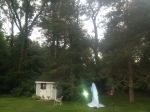
My light rig-UV light with a Mercury Vapor light attached to a tripod. The UV hangs from the top of the sheet.
After that I thought I better get out there and set up my new mothing rig while there was plenty of light to spare. Since it’s a new one, I could run into a few snags and I wanted to be able to see so I could sort them out. Emptying my bladder would have to wait.
I dashed to the store, finished the dinner and got started on that light set-up and it was all-systems-go by the time sundown came. I was pretty sure I wasn’t in renal failure yet, so I snapped some photos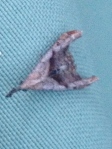 of a couple of moths I saw out by the front porch. Since I work as a mom, wife and naturalist I am, well, a whiz at putting off certain private functions in favor of activities that move the family ship of state forward. Somehow, moths have gotten be a feature on my “must do” list, seemingly ahead even of vital bodily functions. To say that I am a multi-tasker is putting it mildy.
of a couple of moths I saw out by the front porch. Since I work as a mom, wife and naturalist I am, well, a whiz at putting off certain private functions in favor of activities that move the family ship of state forward. Somehow, moths have gotten be a feature on my “must do” list, seemingly ahead even of vital bodily functions. To say that I am a multi-tasker is putting it mildy.
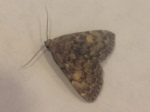 But I am all excited about National Moth Week, a celebration of moths and biodiversity (July 23-29, 2012). It’s the first one ever, and since I discovered what fun “mothing” is, and how much there
But I am all excited about National Moth Week, a celebration of moths and biodiversity (July 23-29, 2012). It’s the first one ever, and since I discovered what fun “mothing” is, and how much there  is to learn, I’ve been avidly trying to soak up as much as I can. Moths are just beautiful-not at all the plain jane grey and brown things you find in old cereal. They come in every color of the rainbow and there are thousands more species than butterflies. In other countries like England there’s been an interest in moths for many years and there are numerous field guides about their native species. Here, the most recent (until this April) field guide to moths was a Peterson’s first issued in 1922. The plates were black and white and in general all the moths looked the same. You had, in my opinion, to be a genius to really identify anything, but some people did.
is to learn, I’ve been avidly trying to soak up as much as I can. Moths are just beautiful-not at all the plain jane grey and brown things you find in old cereal. They come in every color of the rainbow and there are thousands more species than butterflies. In other countries like England there’s been an interest in moths for many years and there are numerous field guides about their native species. Here, the most recent (until this April) field guide to moths was a Peterson’s first issued in 1922. The plates were black and white and in general all the moths looked the same. You had, in my opinion, to be a genius to really identify anything, but some people did.
And now there is a terrific new field guide just published with beautiful plates and commentary. Also published under the Peterson’s imprimatur, the authors are Seabrooke Leckie (who has a nifty blog The Marvelous in Nature on WordPress) and David Beadle. It’s great.  So now anyone can figure out what those moths are that flutter against their back door at night. And you can participate in National Moth Week. Really, anyone can do it. You don’t actually need any special equipment. Just leave an outside light on from dusk until you can’t stand it anymore and you have to go to bed. You may wish to dive in and get fancy lights-it’s up to you, and it is not only an important area of scientific inquiry, it’s fun! You can photograph the moths, or just appreciate them. Or, you can go to one of hundreds of moth events that are being held all over the country. You can find out everything about this at the National Moth Week website, along with how-to’s if you want to start mothing on your own. Take a look at http://nationalmothweek.org/ for more information. Our moth event at Hill-Stead in Farmington, CT is this Friday, June 22 at 8:30.
So now anyone can figure out what those moths are that flutter against their back door at night. And you can participate in National Moth Week. Really, anyone can do it. You don’t actually need any special equipment. Just leave an outside light on from dusk until you can’t stand it anymore and you have to go to bed. You may wish to dive in and get fancy lights-it’s up to you, and it is not only an important area of scientific inquiry, it’s fun! You can photograph the moths, or just appreciate them. Or, you can go to one of hundreds of moth events that are being held all over the country. You can find out everything about this at the National Moth Week website, along with how-to’s if you want to start mothing on your own. Take a look at http://nationalmothweek.org/ for more information. Our moth event at Hill-Stead in Farmington, CT is this Friday, June 22 at 8:30.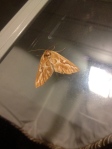
See you on the trails,
Diane Tucker
Naturalist
41.721367
-72.827520
Tags: butterflies, environment, insects, moths, Nature, wildlife
Posted in bugs, butterflies, butterflies and moths, Connecticut nature, environment, insects, moths, Nature, outdoors, Uncategorized, wildlife | 1 Comment »
May 23, 2012
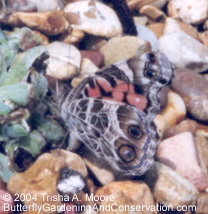
American Lady Butterfly
credit: T. Moore
The other day I lay in the grass and searched for butterfly eggs among the Pussy Toes plants. It was a glorious day, sunny, with gentle breeze and warm earth which felt just right beneath me. I happily spied on the American Lady butterflies as they lit and clambered over the wildflower to find the right places to lay eggs. When I could tell they’d done the deed I’d inch over and, placing my hand lens to my eye I scanned each tiny leaf to see if it sheltered an egg. I am sure if I hadn’t seen them ovipositing I could never have found the eggs, since they are not even a millimeter around. Sitting on a leaf they look like translucent, green-tinged tuffets such as might be pulled up to a fairy’s armchair. Minuscule “seams” radiate from a central point at the top and gather on the bottom. They put me in mind of a pincushion my mother once had, but hers was red.

egg
When you see something like that it makes you realize how much there is around you that you can’t or don’t notice. The American Lady butterfly itself is a lovely creature, and we are fortunate to have them come through this area during their annual migration. The size of the migrations vary widely, so some years just a few flutter through and other years like this one they pour through New England in overwhelming numbers. I don’t mind a bit being inundated with butterflies. Who would? A cousin of the American Lady Butterfly, the Painted Lady, comes this way too. Sunny days with a little breeze for lift have made the Hill-Stead meadows seem like a colorful insect freeway. We have quite a bit of Pussy Toes, a preferred host plant, as well as Pearly Everlasting-related to Pussy Toes and just as relished by the American and Painted Lady butterflies. So they are out there in colorful multitudes. They are hard to tell apart-it’s only a matter of a couple of extra dots and they might easily have been classified under one name, with the “extra dot” ones considered a variation.
With names like “American” and “Painted Lady” it sounds as though one bug were upstanding and the other morally derelict. Since Linnaeus’ time, we’ve had various reasons for the naming of things and before that the Greeks and Romans had their methods. Darwin’s discoveries threw a wrench into Linnaeus’ system, and Cladistics is a newer game still. So there is a continuum of naming the more we learn about our world. Some might say it doesn’t matter, a “rose by another name would smell as sweetly.” But I’ve noticed that as children grow they like to try on different nicknames like different clothing,experimenting with how a certain identity makes them feel. So names matter. My husband spent some time as “Jack Blackthorn”, which as a child he thought had a brave and rakish air. But my daughter, who started life with a Chinese name meaning “good luck” and “jade” has not yet made an effort to discard the name we gave her. We chose her first name because we just loved it. Many parents of Chinese daughters leave the Chinese name in place as a “middle” name, but we didn’t. Her second name is for my mother, who died shortly before she was born and who would have been besotted with her. We wanted not to disrespect her origins, but to embrace her entirely as a member of our family as certain as she had come to us “the old-fashioned way”. We use her Chinese name as a nickname, as it is as surely her name as much as the others. I love that name too-I used it when we were first together and I snuggled her against me so she would know the love was for her and no one else-days of sharing the caregiver with a dozen others were over. Perhaps at some point she’ll want us to call her something else, or she’ll decide to use her Chinese name. You never know what kids will do. I hope I have the sense and good grace just to swallow and use the tag she wants instead of making it all about me. Giving names is one thing, and accepting them is another. Unlike plants and bugs, we have some choice in the matter.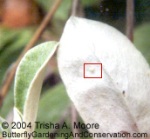
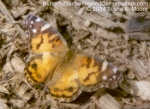 Theodate named her house Hill-Stead. As a name it perfectly conveys the two most important elements in the Hill-Stead backstory, specifically that she was deeply concerned with and connected to the land the house sits on. The home was sited at the top of a hill with the help of the landscape architect, exploiting the natural features so that each window framed a perfect landscape. They could have sited it in many places on over 250 acres of land, but they faced it toward the Barn Door Hills. Of equal importance is “Stead” meaning steady, rooted home. Theodate was determined to create a secure and anchored place for her family to live, underscoring her need for hearth and home to be rooted in the land and nature.
Theodate named her house Hill-Stead. As a name it perfectly conveys the two most important elements in the Hill-Stead backstory, specifically that she was deeply concerned with and connected to the land the house sits on. The home was sited at the top of a hill with the help of the landscape architect, exploiting the natural features so that each window framed a perfect landscape. They could have sited it in many places on over 250 acres of land, but they faced it toward the Barn Door Hills. Of equal importance is “Stead” meaning steady, rooted home. Theodate was determined to create a secure and anchored place for her family to live, underscoring her need for hearth and home to be rooted in the land and nature.
See you on the trails,
Diane Tucker
Estate Naturalist
41.721367
-72.827520
Tags: butterflies, environment, Nature, outdoors, plants, Uncategorized, wildflowers, wildlife
Posted in butterflies, environment, insects, natural history, Nature, outdoors, plants, Uncategorized, wildflowers, wildlife | 7 Comments »
April 27, 2012
On March 25 Margaret Czepiel, a Girl Scout from West Hartford, started her ambitious Gold Award project here at Hill-Stead. For those not ‘down’ with scouting parlance, “Gold Award” equals “Eagle Scout project” if you are a Girl Scout.
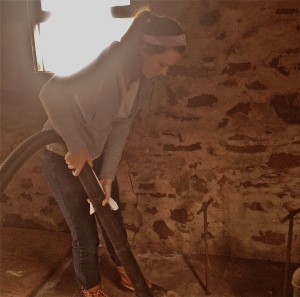
Margaret Czepiel-Is that a halo over her head?
There were scouts of all kinds there to help Margaret. Her goal is to transform our Pump House into a jewel-box nature center, an exhibit space highlighting the natural history of Hill-Stead. Together they removed decades of dust, repainted windows, removed brush, erected a bird house and identified future steps to take to fulfill the objective. Margaret’s family was there, as well as museum staff. Margaret carefully determined how best to preserve the historical import of the building, working with Curator Melanie Anderson, Eric Easton of Operations and Naturalist Diane Tucker. At the end of the day they all packed up their vans, picked up their equipment and were gone in a puff of dust, which I could swear was the last remaining particles of rust-laden detritus from the Pump House interior. Either that or the end of a dream sequence. But no, they’ll be back, and soon, for Margaret plans to measure for pedestals and stands that will sit over the old plumbing fittings, providing places to showcase things as well as safety in navigating around the room free of tripping hazards. Stay tuned for more on Margaret and the Natural History Bungalow-to-be.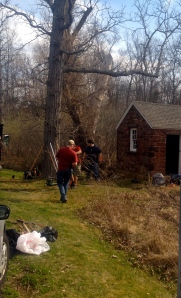
41.721367
-72.827520
Tags: children and nature, environment, Girl Scouts, Nature, outdoors, Uncategorized
Posted in Connecticut nature, environment, museums, natural history, Nature, New England Museums, outdoors, Uncategorized | 7 Comments »
March 16, 2012
We’ve had a spate of early warm weather around here and though it wasn’t even St. Patrick’s Day the 60 degree temperatures had everyone in a springtime frame of mind. All the same, it was late for cleaning them out. So it seemed high time to get out there and get the job done, since Eastern Bluebirds have had breeding on their mind well before now. It was so beautiful, I wasn’t sure my words could do it justice, so I decided to bring you along with me on my walk. I hope you enjoy it. To know more about both Bluebirds and Pussy Willows mentioned in the little film, there are earlier posts on the blog with more detail.
See you on the trails,
Diane Tucker
Estate Naturalist
41.721367
-72.827520
Tags: birds, environment, hiking, natural history, Nature, outdoors, Uncategorized, wildlife
Posted in birds, environment, hiking, natural history, Nature, outdoors, Uncategorized, walking, wildlife | 16 Comments »
March 8, 2012
 I would never let my husband buy a house without me. I want to do my own picking, choosing and criticizing of wallpaper. But it happens that people get sudden transfers and must jet off to find a new family homestead in 48 hours. Whoever stays home to pack the boxes has to rely on their partner to make a good pick.
I would never let my husband buy a house without me. I want to do my own picking, choosing and criticizing of wallpaper. But it happens that people get sudden transfers and must jet off to find a new family homestead in 48 hours. Whoever stays home to pack the boxes has to rely on their partner to make a good pick.
Lady Red-Winged Blackbirds wouldn’t mind at all. Around this time of year, male Red-Wings are returning north in droves, along with other Icterids -a fancy word for blackbirds and their kin. Grackles, cowbirds, Rusty Blackbirds and others form large, loose flocks and begin making their way to summer breeding grounds. Males arrive two to three weeks in advance of the females, scouting out the best nesting sites. Here at Hill-Stead I start looking for them during the latter part of February. The population at our pond increases through the month of March as new waves of migrants work their way up north. The minute I hear that first telltale Red-Wing call, I know that spring has really started. It’s a change-of-season bellweather, often before any meteorological warmth of significance has occurred. With Red-Winged Blackbirds in place, it isn’t long before Tree Swallows arrive and Wood Frogs begin calling. The wind may still blow chill, but the sun is a stronger one by the time the blackbirds come and with my outside work I begin a tan on my face and the backs of my hands. Glove-wearing is definitely over for now.
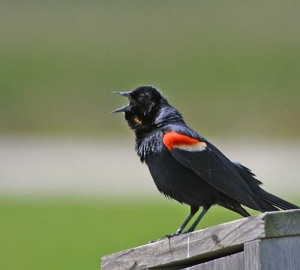 These Red-Wing fellows are handsome husbands, recognized by their shiny black feathers and the tri-colored epaulettes or “badges” on their wings. Of course, this is where their name comes from. The badges are an important key to the house hunting. The whole reason the birds are back early is to settle into an advantageous nesting territory, the better to snag a “trophy” wife. For the female bird will be looking for the chap who can optimize her breeding opportunities-the best nesting area and “go-getter”-type spouse will equal her greatest chance of having a large number of living offspring. Trophy wife, trophy husband, trophy real estate. It’s like the Farmington Valley in miniature.
These Red-Wing fellows are handsome husbands, recognized by their shiny black feathers and the tri-colored epaulettes or “badges” on their wings. Of course, this is where their name comes from. The badges are an important key to the house hunting. The whole reason the birds are back early is to settle into an advantageous nesting territory, the better to snag a “trophy” wife. For the female bird will be looking for the chap who can optimize her breeding opportunities-the best nesting area and “go-getter”-type spouse will equal her greatest chance of having a large number of living offspring. Trophy wife, trophy husband, trophy real estate. It’s like the Farmington Valley in miniature.
The male Red-Wing uses his badges to remarkable purpose. They are red, yellow and white and the bird can flash them at will, showing the whole thing, or just a bit. In fact, he can hide them, too, in a kind of stealth move. Not unexpectedly, males use a big flash of the whole thing at birds trying to enter a territory they’ve claimed for their own. They are essentially saying, “No chance, buddy.” Having good badges indicates how far up on the social scale you are. Birds that are trying to get a territory of their own may hide their badges completely and enter an already claimed area to see how well the resident bird is apt to defend his spot. Really macho blackbirds even defend against the badgeless, just in case. Inexperienced or just plain foolish males may fail to defend, to their sorrow. Enterprising and stealthy badge hiders may sometimes manage to prise away a good territory. He who hesitates is lost!
 Before long the tops of trees near our pond will fairly bristle with Red-Wings singing out and flashing their badges. There are, in my opinion, few things prettier than a flashing Red-Wing Blackbird at the top of a tree on a sunny day. It’s even better if he’s singing out his bold cry, “Conkareeeee!” Somehow these birds command attention in a unique way, and their looks and ways bring life into sharp focus. They remind me to live in the moment, leave the past winter to itself and breathe in the warming spring breezes.
Before long the tops of trees near our pond will fairly bristle with Red-Wings singing out and flashing their badges. There are, in my opinion, few things prettier than a flashing Red-Wing Blackbird at the top of a tree on a sunny day. It’s even better if he’s singing out his bold cry, “Conkareeeee!” Somehow these birds command attention in a unique way, and their looks and ways bring life into sharp focus. They remind me to live in the moment, leave the past winter to itself and breathe in the warming spring breezes.
See you on the trails,
Diane Tucker
Estate Naturalist
41.721367
-72.827520
Tags: birds, environment, Hill-Stead Museum, natural history, Nature, outdoors, red-winged blackbirds, Uncategorized, wildlife
Posted in birds, environment, natural history, Nature, outdoors, Uncategorized, wildlife | 9 Comments »
February 25, 2012
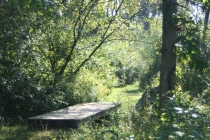 I’m not the most sophisticated naturalist in the world. I know some some birds, wildflowers and some science around living things,but I see myself as more of a carnival barker for nature. What I really want to do is shout, “Hey look at that, isn’t that neat? Here’s WHY!” I think in my line of work a certain ignorance may be a plus, which is obviously why my employer seems to be happy with my work. What I mean is it’s tough to get charged up about Acalypa Rhomboidea. But the common name Green Adder’s Mouth sounds mysterious and sexy. If you follow that salacious moniker up with the fact that it’s an endangered plant and not a dirty movie, an orchid growing 4-10 inches tall with miniscule flowers well- camouflaged by color that blossoms from June to August, well, cheeks may color with interest. (Folks blush about orchids more readily these days anyway, after that movie with Meryl Streep, The Orchid Thief.) So I use common names, not the Latin, when I go walking with groups. What I want is for people to (quite literally) catch the nature bug. They may catch it from me, and then go far beyond. I try to be as infectious as possible. Nature is important.
I’m not the most sophisticated naturalist in the world. I know some some birds, wildflowers and some science around living things,but I see myself as more of a carnival barker for nature. What I really want to do is shout, “Hey look at that, isn’t that neat? Here’s WHY!” I think in my line of work a certain ignorance may be a plus, which is obviously why my employer seems to be happy with my work. What I mean is it’s tough to get charged up about Acalypa Rhomboidea. But the common name Green Adder’s Mouth sounds mysterious and sexy. If you follow that salacious moniker up with the fact that it’s an endangered plant and not a dirty movie, an orchid growing 4-10 inches tall with miniscule flowers well- camouflaged by color that blossoms from June to August, well, cheeks may color with interest. (Folks blush about orchids more readily these days anyway, after that movie with Meryl Streep, The Orchid Thief.) So I use common names, not the Latin, when I go walking with groups. What I want is for people to (quite literally) catch the nature bug. They may catch it from me, and then go far beyond. I try to be as infectious as possible. Nature is important.
I’m not a scientist. But I sure am enthusiastic about the science of nature. It seems my I’ve spent my life walking outside and saying “What the heck is that?” Unable to leave the question unanswered, over the years I’ve scoured books and (these days) websites, gone to museums, and bought innumerable field guides in order to achieve a certain intimacy with the natural world. I’m comfortable there, and to a degree I see how it all goes together and why one thing needs another. Interdependence is a fundamental element of life. As humans we are included in that. And I think everyone ought to know it. So I’m shouting it out in my simple terms, the ones that most of us understand and grasp more viscerally.
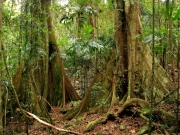 I really wish they would stop teaching about the rain forest in elementary school classrooms. Don’t get me wrong, I find the rain forest as fascinating as anyone, and I worry about it a lot. But that’s why I want them to stop scaring the little kids about it. It’s pretty hard to teach about the rain forest without mentioning that it’s going to be a housing development before the children graduate from college. Why bother being excited about nature when there’s no point? That’s the lesson kids take away. Better to save the rainforest for middle and high schoolers and let them exercise some critical thinking on its problems. Instead, get the younger kids outside right here in their own environment. Show them how exciting their native forest is by letting them handle frogs and bugs, find crickets, catch fireflies, do the bee dance, learn their wildflowers. What we have here is as thrilling as the nature found all over the planet.
I really wish they would stop teaching about the rain forest in elementary school classrooms. Don’t get me wrong, I find the rain forest as fascinating as anyone, and I worry about it a lot. But that’s why I want them to stop scaring the little kids about it. It’s pretty hard to teach about the rain forest without mentioning that it’s going to be a housing development before the children graduate from college. Why bother being excited about nature when there’s no point? That’s the lesson kids take away. Better to save the rainforest for middle and high schoolers and let them exercise some critical thinking on its problems. Instead, get the younger kids outside right here in their own environment. Show them how exciting their native forest is by letting them handle frogs and bugs, find crickets, catch fireflies, do the bee dance, learn their wildflowers. What we have here is as thrilling as the nature found all over the planet.
I’m lucky. I have Hill-Stead Museum’s woodland, wetland and meadows with which to dazzle visitors. In a simple way I can show off the exciting nature of environment. In our 152 acres there is enough titillation for the 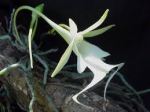 jaded. We even have rare orchids.
jaded. We even have rare orchids.
See you on the trails,
Diane Tucker, Estate Naturalist
Tags: Connecticut, elementary school classrooms, environmental education, museums, natural history, Nature
Posted in environment, hiking, museums, natural history, Nature, New England Museums, outdoors, Uncategorized, walking, wildlife | 15 Comments »
September 20, 2011
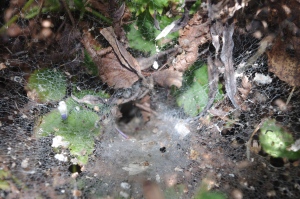 There has been an Funnel Web Spider living in the corner of our bathroom windowsill this summer. I call her Svetlana, after the one-legged health aid in the “Sopranos”. TV’s Svetlana had nerves of steel and dispensed truth from one side of her mouth while the other was clamped down on a cigarette. It took me a while to settle on a name, but I decided that in spite of the disparity in the number of their legs they had much in common.
There has been an Funnel Web Spider living in the corner of our bathroom windowsill this summer. I call her Svetlana, after the one-legged health aid in the “Sopranos”. TV’s Svetlana had nerves of steel and dispensed truth from one side of her mouth while the other was clamped down on a cigarette. It took me a while to settle on a name, but I decided that in spite of the disparity in the number of their legs they had much in common.
My husband wanted to close the window the other night. I told him flat out no and explained that Svetlana wouldn’t be able to make it out of her little funnel (which she cleverly built into the channel of the window sill) if we closed the window. John is a champ, and has gotten used to a lot over the years, so he didn’t even bat an eye when I explained I was talking about a spider. He has even learned to feign interest,bless him, and asked what kind of spider was going to mean wearing a sweater while he brushed his teeth. When I said, “Funnel Web”, he whooped “Whoa! Poisonous! The SAS Survival Guide says they are one of the most poisonous spiders in the world!” I knew I shouldn’t have gotten him that book for Christmas. But Svetlana is a NORTH AMERICAN funnel web, not the Australian spider the SAS warns of. That is not to say, however, that she hasn’t got her own little arsenal of survival tricks.
Funnel Web spiders are sometimes called “grass” spiders, for their habit of making trampoline-like webs in the grass or shrubbery. If you look carefully you can sometimes see a little tunnel leading to who-knows-where in the grass or greens. This is where the spider usually waits for another bug to fall or fly into the web, whereupon the spider scurries out and bites the victim. The insides of the victim liquify and the spider returns later and drinks him up. The web doesn’t even have to be made of sticky silk to work perfectly.
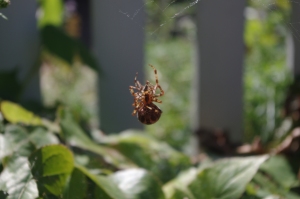 Spiders can be quite pretty and FW’s are no exception. They have stripey legs, and lines on their backs. There are usually eight eyes in rows of four over four which glitter if they catch the light properly. Of course, you can see all of this better and better as the spider molts its exoskeleton and gets progressively bigger, between four and twelve times in a summer, depending on the species.
Spiders can be quite pretty and FW’s are no exception. They have stripey legs, and lines on their backs. There are usually eight eyes in rows of four over four which glitter if they catch the light properly. Of course, you can see all of this better and better as the spider molts its exoskeleton and gets progressively bigger, between four and twelve times in a summer, depending on the species.
Spiders are quite versatile, especially the Funnel Web. This time of year the vegetation has lots of dew in the morning and when I walk in the meadow I can see many of their webs spread out on the grass like so much laundry drying, the shapes made visible by the moisture. It’s fun but also a bit wicked to take a little branch and disturb the web ever so slightly so you can watch the spider dart out in the hope that a juicy meal has run afoul of her lines.
I made a little movie recently of some webs I found at Hill-Stead, and I added a few frames of Svetlana. There’s a love scene even though the whole thing only lasts four and a half minutes. Don’t get too invested in the romance, though. It ends badly for the fellow. Some spider brides kill the groom, wrap him up and eat him later. The couple in my movie are orb weavers, but unfortunately for male spiders, the habit is not confined to that species.
Get your popcorn, and I’ll see you on the trails.
Diane Tucker
Estate Naturalist
Tags: environment, Hill-Stead Museum, insects, natural history, Nature, outdoors, spiders, Uncategorized, wildlife
Posted in bugs, environment, insects, invertebrates, natural history, Nature, New England Museums, outdoors, spiders, Uncategorized, wildlife | 13 Comments »
August 4, 2011
 If I see another kid stomp on a bug during a nature walk, or scream and flail his arms around when he sees a bee I will lose my mind. And that’s only the children. You’d never believe some of the wacky things adults do on nature walks, like the school teacher who screamed and ran away and out of sight leaving 25 astonished third-graders with me and a sleeping garter snake we had just found under a bug board. Or the dozens of people you see going down into the Grand Canyon in high heels. But it’s little wonder when you consider how disconnected from life in the outdoors we are. Most people who attend nature hikes are unschooled in basic natural science and history. Many parents view nature hikes as strictly an entertainment for children, or for a springtime “science-lite” field trip from school with a hidden hijinks agenda.
If I see another kid stomp on a bug during a nature walk, or scream and flail his arms around when he sees a bee I will lose my mind. And that’s only the children. You’d never believe some of the wacky things adults do on nature walks, like the school teacher who screamed and ran away and out of sight leaving 25 astonished third-graders with me and a sleeping garter snake we had just found under a bug board. Or the dozens of people you see going down into the Grand Canyon in high heels. But it’s little wonder when you consider how disconnected from life in the outdoors we are. Most people who attend nature hikes are unschooled in basic natural science and history. Many parents view nature hikes as strictly an entertainment for children, or for a springtime “science-lite” field trip from school with a hidden hijinks agenda.
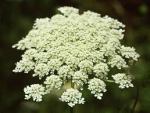 But we have some little successes. Two weekends ago I had a completely bug-phobic mother bring her children to “moth night”, our annual evening event when I bait trees and set up black lights to bring in moths and other night insects so they can be seen up close. You have to love a heroic parent like that, but to her surprise and mine she had a blast. Last weekend, I had kids and adults out in our meadow munching like happy cows on Queen Anne’s Lace roots, and arguing over the last bits. Just in case you aren’t on any of the very worthy survivalist list serves around, Queen Anne’s Lace is the cousin of the carrot and the roots smell quite alike. In darkness you’d be hard pressed to tell them apart. But the QAL tastes like an old, woody carrot, not a fresh one.
But we have some little successes. Two weekends ago I had a completely bug-phobic mother bring her children to “moth night”, our annual evening event when I bait trees and set up black lights to bring in moths and other night insects so they can be seen up close. You have to love a heroic parent like that, but to her surprise and mine she had a blast. Last weekend, I had kids and adults out in our meadow munching like happy cows on Queen Anne’s Lace roots, and arguing over the last bits. Just in case you aren’t on any of the very worthy survivalist list serves around, Queen Anne’s Lace is the cousin of the carrot and the roots smell quite alike. In darkness you’d be hard pressed to tell them apart. But the QAL tastes like an old, woody carrot, not a fresh one.
Looking over our meadows at Hill-Stead there are loads of wildflowers keeping Queen Anne and her lace company right now. Joe Pye Weed and Goldenrod are starting up, Black-Eyed Susan and Milkweed have been around a few weeks. The clover has been blooming for months. Clover, a member of the pea or legume family, grows in white, pink (often called “red”), and yellow (called “hop”), as well as a fuzzy, ochre-colored one called “rabbit’s foot”. If your yard had clover, a “good” yard service would advise you to eradicate it with pesticides. Aside from the pretty colors and the near continuous blooming habit, here’s why you might consider a stay of execution.
been blooming for months. Clover, a member of the pea or legume family, grows in white, pink (often called “red”), and yellow (called “hop”), as well as a fuzzy, ochre-colored one called “rabbit’s foot”. If your yard had clover, a “good” yard service would advise you to eradicate it with pesticides. Aside from the pretty colors and the near continuous blooming habit, here’s why you might consider a stay of execution.
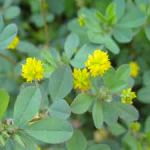 Nitrogen. Essential for life, it’s in about 80% of the air you breathe and is called “free nitrogen”, though it’s anything but free to us since we can’t directly use the airborne variety. Only “fixed nitrogen” is available to animals and plants. Where do we get it? Plants need nitrogen in the form of either nitrates or ammonia. These come from the soil, where they are dissolved in soil water, are taken up by the roots of the plants and start wending their way through the food chain. But, how do the nitrates and ammonia get into the soil? Nitrogen is “fixed”, or converted from free nitrogen in the air to nitrates (or ammonia) in various ways. Of course, people can add nitrogen to soil in the form of fertilizer. And lightening can cause reactions which result in the creation of nitrates. There is also “nitrogen fixing bacteria” that converts free nitrogen from the atmosphere into a useable form. The bacteria have enzymes that cause the change. Here’s where the clover comes in. The bacteria live in nodules on the roots of leguminous plants,-yes! Plants like clover, with both good looks AND talent.
Nitrogen. Essential for life, it’s in about 80% of the air you breathe and is called “free nitrogen”, though it’s anything but free to us since we can’t directly use the airborne variety. Only “fixed nitrogen” is available to animals and plants. Where do we get it? Plants need nitrogen in the form of either nitrates or ammonia. These come from the soil, where they are dissolved in soil water, are taken up by the roots of the plants and start wending their way through the food chain. But, how do the nitrates and ammonia get into the soil? Nitrogen is “fixed”, or converted from free nitrogen in the air to nitrates (or ammonia) in various ways. Of course, people can add nitrogen to soil in the form of fertilizer. And lightening can cause reactions which result in the creation of nitrates. There is also “nitrogen fixing bacteria” that converts free nitrogen from the atmosphere into a useable form. The bacteria have enzymes that cause the change. Here’s where the clover comes in. The bacteria live in nodules on the roots of leguminous plants,-yes! Plants like clover, with both good looks AND talent.
 In short, clover unlocks a key to the entire food chain. I love it, and I keep what I have growing in my yard. Our meadows here at Hill-Stead are filled to the brim with clover-fixed-nitrogen and the food chain to go with it. I love showing it off to visitors. I don’t think that nature walks need to be treated as just a Sunday afternoon diversion for the kids, yet I don’t need everyone to be a citizen scientist, either. I would like for guests to come away from our programs with a fresh understanding of the outdoors, one that sees the human individual as part of the natural continuum, a steward and caretaker and, in fact, a party to the food chain itself. You don’t have to know the ins and outs of the nitrogen cycle for that. But you do have to go outside once in a while and look at the clover.
In short, clover unlocks a key to the entire food chain. I love it, and I keep what I have growing in my yard. Our meadows here at Hill-Stead are filled to the brim with clover-fixed-nitrogen and the food chain to go with it. I love showing it off to visitors. I don’t think that nature walks need to be treated as just a Sunday afternoon diversion for the kids, yet I don’t need everyone to be a citizen scientist, either. I would like for guests to come away from our programs with a fresh understanding of the outdoors, one that sees the human individual as part of the natural continuum, a steward and caretaker and, in fact, a party to the food chain itself. You don’t have to know the ins and outs of the nitrogen cycle for that. But you do have to go outside once in a while and look at the clover.
Tags: children and nature, Connecticut, ecology, environment, hiking, Hill-Stead Museum, insects, museums, natural history, Nature, outdoors, plants, Uncategorized, walking, wildflowers, wildlife
Posted in Connecticut nature, Conservation, environment, museums, natural history, Nature, New England Museums, outdoors, plants, rabbit, Uncategorized, wildflowers, wildlife | 13 Comments »
March 27, 2011
 Some of my friends are on a “cleanse”. You need the book to participate- $9.16 on Amazon.com. You give up “obstacles to digestion” which apparently include eggs, nuts, dairy, tomatoes, eggplant, potatoes, peppers, meat, soy, cheese, wheat, and coffee. Since this doesn’t leave a lot you can actually eat, there is a line of shakes and supplements, $425 for the most popular package. Evidently people are contaminated with poisons from a diet which presumably includes tomatoes and peppers (see above list for other possibilities), and it is recommended that the cleanse continue for at least a month. If you have had the habit of eating any “allergen, mucous-forming or inflammatory” foods (see above), then you need to take and stay on a pre-cleanse program for a time before you can get into the actual cleansing. The more poisonous your previous diet, the longer the pre-cleanse. Then comes the gastrointestinal scrubbing during which you will need to take pills with names like Clear, Equilibrium, Pass, Ease and so on. The image I got when I heard about these wasn’t good at all, especially “pass” and “ease”.
Some of my friends are on a “cleanse”. You need the book to participate- $9.16 on Amazon.com. You give up “obstacles to digestion” which apparently include eggs, nuts, dairy, tomatoes, eggplant, potatoes, peppers, meat, soy, cheese, wheat, and coffee. Since this doesn’t leave a lot you can actually eat, there is a line of shakes and supplements, $425 for the most popular package. Evidently people are contaminated with poisons from a diet which presumably includes tomatoes and peppers (see above list for other possibilities), and it is recommended that the cleanse continue for at least a month. If you have had the habit of eating any “allergen, mucous-forming or inflammatory” foods (see above), then you need to take and stay on a pre-cleanse program for a time before you can get into the actual cleansing. The more poisonous your previous diet, the longer the pre-cleanse. Then comes the gastrointestinal scrubbing during which you will need to take pills with names like Clear, Equilibrium, Pass, Ease and so on. The image I got when I heard about these wasn’t good at all, especially “pass” and “ease”.
When you complete the tour of duty, you will feel energy and clarity, and be at least $434.16 lighter. Starvation for the privileged. But if you want to be on the cutting edge of weight loss fashion, look no further. The book alone is a runaway bestseller.
I am polite about all this. But I shudder at the frivolity while people the world over could eat for months on $425 and feel overfed. Being riven with hunger is torture. Real starvation means the Cheezits aren’t six feet away in the cabinet if you tire of it. The price of such hunger far exceeds $425. It is known, tragically, by millions.
On another plane, but no less pitiable is the deprivation known this winter by animals and birds throughout our area. As the snow melted here at Hill-Stead I sadly found quite a number of bird and animal corpses. In a harsh winter, hunger is a ruthless creditor.
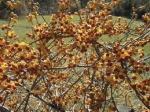 This year birds gobbled up late summer berries like wild grape, pokeweed, poison ivy and blueberries before the fall was even over, so they had to start in on winter berries early. Winter berries include cedar, sumac and winterberry. They were in turn eaten up early. Starvation set in and with no other crop to draw from, many birds switched to eating alien and ornamental plants like multiflora rose and bittersweet. Without these foods as sustenance, I would have found quite a few more corpses during my springtime wanderings. This got me thinking. Because the birds had to switch over to eating invasive plants , it may mean that invasives will spread more than usual when spring warms up and the seeds dispersed by the birds begin to grow.
This year birds gobbled up late summer berries like wild grape, pokeweed, poison ivy and blueberries before the fall was even over, so they had to start in on winter berries early. Winter berries include cedar, sumac and winterberry. They were in turn eaten up early. Starvation set in and with no other crop to draw from, many birds switched to eating alien and ornamental plants like multiflora rose and bittersweet. Without these foods as sustenance, I would have found quite a few more corpses during my springtime wanderings. This got me thinking. Because the birds had to switch over to eating invasive plants , it may mean that invasives will spread more than usual when spring warms up and the seeds dispersed by the birds begin to grow.
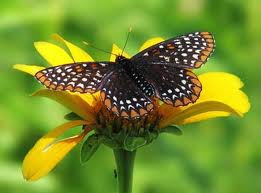 I began to consider the further effect of an increase in alien plants. I’ll use Hill-Stead’s experience with a butterfly, the Baltimore Checkerspot, as the perfect example. This insect has a favorite food. And like a picky child, if the favorite food is unavailable it simply won’t eat. But the bug has more gumption than most children, and it dies out in places where its’ preferred plant has died out. No plant, no bug. In this way, once common insects become more local then gradually go extinct. Hill-Stead used to be a last gasp location for the Baltimore Checkerspot since we had quite a bit of turtlehead, the favorite plant. But the meadow began to be mowed in wider and wider margins, and the turtlehead went. It was long before my time and anyone else here now. But the butterfly census folks still shake their heads, and so do I. The Baltimore Checkerspot is not unique in its stubbornness. Every single insect is the same.
I began to consider the further effect of an increase in alien plants. I’ll use Hill-Stead’s experience with a butterfly, the Baltimore Checkerspot, as the perfect example. This insect has a favorite food. And like a picky child, if the favorite food is unavailable it simply won’t eat. But the bug has more gumption than most children, and it dies out in places where its’ preferred plant has died out. No plant, no bug. In this way, once common insects become more local then gradually go extinct. Hill-Stead used to be a last gasp location for the Baltimore Checkerspot since we had quite a bit of turtlehead, the favorite plant. But the meadow began to be mowed in wider and wider margins, and the turtlehead went. It was long before my time and anyone else here now. But the butterfly census folks still shake their heads, and so do I. The Baltimore Checkerspot is not unique in its stubbornness. Every single insect is the same.
But here’s the thing: 96% of terrestrial birds (as opposed to sea-going birds, for example) feed their babies on insects and spiders. What determines how many and what kind of insects are around? Plants! So, if we keep creating scenarios where invasives multiply, we will continue on a crash course with insect extinction and by extension bird extinction and by further extension, well, you get the idea.
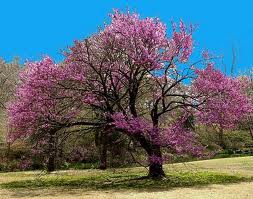
Eastern Redbud (native)
Now it probably isn’t anyone’s specific fault that we had a bad winter and the birds had
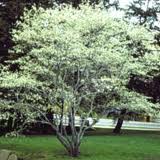
Serviceberry (native)
to resort to eating multiflora rose hips. But it is our fault if we fail to increase our use of native species when we plant around our homes, parks and ornamental gardens. In this way, the birds and insects and everything that depends on them will have a leg up by having the proper food to eat. More native plants, more insects, more birds. More, please.
See you on the trails,
Diane Tucker
Estate Naturalist
Tags: birds, butterflies, Connecticut, Conservation, ecology, environment, hiking, Hill-Stead Museum, insects, invasive plants, natural history, Nature, outdoors, plants, sustainability, trees, Uncategorized, walking, wildflowers, wildlife
Posted in birds, bugs, butterflies, Conservation, environment, hiking, insects, invertebrates, museums, natural history, Nature, New England Museums, outdoors, plants, spiders, sustainability, trees, Uncategorized, walking, wildflowers, wildlife | 7 Comments »












































